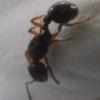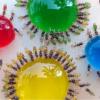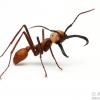- Formiculture.com
- Forums
- Gallery
- Members
- Member Map
- Chat

Heraklion, Crete, Greece 21-09-2016
Started By
GiannisF77
, Sep 21 2016 12:42 PM
17 replies to this topic
#1
 Offline
-
Posted September 21 2016 - 12:42 PM
Offline
-
Posted September 21 2016 - 12:42 PM
Location of Colection: Heraklion city suburbs, Univercity of Crete Heraklion campus.
Date of Colection: 20-09-2016
Habitat: Suburbs, meditterenean habitat, right after intense 1 hour storm after a long dry and hot period.
Length: 12 +-1 mm
Color: Black with very dark brown legs.
Texture: smooth and shiny
Patterns: 3-stripped gastrer seperated by 2 dark brown lines and a w shapped connection between thorax (mesosoma) and gaster.
Other: These little buggers were absolutely everywhere! I counted probably more than 30 in a couple of hours.
I will post pics soon.
Date of Colection: 20-09-2016
Habitat: Suburbs, meditterenean habitat, right after intense 1 hour storm after a long dry and hot period.
Length: 12 +-1 mm
Color: Black with very dark brown legs.
Texture: smooth and shiny
Patterns: 3-stripped gastrer seperated by 2 dark brown lines and a w shapped connection between thorax (mesosoma) and gaster.
Other: These little buggers were absolutely everywhere! I counted probably more than 30 in a couple of hours.
I will post pics soon.
#2
 Offline
-
Posted September 21 2016 - 1:15 PM
Offline
-
Posted September 21 2016 - 1:15 PM
Probably some sort of Camponotus or Formica
Visit us at www.canada-ant-colony.com !
#3
 Offline
-
Posted September 21 2016 - 1:18 PM
Offline
-
Posted September 21 2016 - 1:18 PM
So I also collected a dead one for photos. Seems she has her half left antena missing ang she has a big wound on her gaster... Poor thing...
Edited by GiannisF77, September 21 2016 - 1:19 PM.
#4
 Offline
-
Posted September 21 2016 - 2:34 PM
Offline
-
Posted September 21 2016 - 2:34 PM
#5
 Offline
-
Posted September 21 2016 - 6:04 PM
Offline
-
Posted September 21 2016 - 6:04 PM
Camponotus sp
Visit us at www.canada-ant-colony.com !
#6
 Offline
-
Posted September 21 2016 - 6:21 PM
Offline
-
Posted September 21 2016 - 6:21 PM
Sorry!! I didn't notice the petiole. She appears to be crematogaster
Visit us at www.canada-ant-colony.com !
#7
 Offline
-
Posted September 21 2016 - 6:22 PM
Offline
-
Posted September 21 2016 - 6:22 PM
Two petiole nodes, so a myrmicine. Looks like Messor to me.
If you've enjoyed using my expertise and identifications, please do not create undue ecological risk by releasing your ants. The environment which we keep our pet insects is alien and oftentimes unsanitary, so ensure that wild populations stay safe by giving your ants the best care you can manage for the rest of their lives, as we must do with any other pet.
Exotic ants are for those who think that vibrant diversity is something you need to pay money to see. It is illegal to transport live ants across state lines.
----
Black lives still matter.
#8
 Offline
-
Posted September 21 2016 - 6:24 PM
Offline
-
Posted September 21 2016 - 6:24 PM
What's Messor? I don't research queens that I can't find
Visit us at www.canada-ant-colony.com !
#9
 Offline
-
Posted September 21 2016 - 6:27 PM
Offline
-
Posted September 21 2016 - 6:27 PM
What's Messor? I don't research queens that I can't find
Yeah, I feel fairly ignorant of ants I have no chance at finding. Messor is a polymorphic, Old-World harvester ant. We have something similar in the West that was moved to the genus Veromessor.
Edited by Batspiderfish, September 21 2016 - 6:29 PM.
If you've enjoyed using my expertise and identifications, please do not create undue ecological risk by releasing your ants. The environment which we keep our pet insects is alien and oftentimes unsanitary, so ensure that wild populations stay safe by giving your ants the best care you can manage for the rest of their lives, as we must do with any other pet.
Exotic ants are for those who think that vibrant diversity is something you need to pay money to see. It is illegal to transport live ants across state lines.
----
Black lives still matter.
#10
 Offline
-
Posted September 21 2016 - 9:36 PM
Offline
-
Posted September 21 2016 - 9:36 PM
Somebody in the chat mentioned it could be a messor.
#11
 Offline
-
Posted November 6 2016 - 9:04 AM
Offline
-
Posted November 6 2016 - 9:04 AM
Yes Messor sp. typical at this time around the Mediterranean. You are lucky to live on Crete! There are so many cool species of ants there.
#12
 Offline
-
Posted November 14 2016 - 3:44 AM
Offline
-
Posted November 14 2016 - 3:44 AM
Thanks for the help guys! I really appreciate your help!
So, after a little research, I was almost sure that these queens were Messor Meridionale. However, these species are one of the few Messor sp. that do not hibernate. However, its been nearly two months and they still have not laid eggs. Half of them seem to be very hypotonic, so I am guessing they are transitioning into a state of hibernation, as more and more often the temperature is dropping below 20 degrees Celcius. So in case they hibernate in the next month, my guess will probably be wrong, and I will have to keep trying to identify them. Its hard to do so though, judging only by the queens appearance.
I also had a high mortality rate, as only 4 out of the original 10 queens survived. It could be anything from my mistake to city polution. Anyway, these last 4 seem healthy enough.
Now I am not sure whether or not should I feed them. I placed a drop of honey into each test tue setup twice, with a time interval of two weeks. They seemed pleased, hahah. I would like to know though how much is too much. don't wanna stress them a lot.
#13
 Offline
-
Posted February 27 2017 - 8:42 AM
Offline
-
Posted February 27 2017 - 8:42 AM
Lads! Boys! Lads! Months later one of the queens laid her first eggs! Five of them! #excitement
#14
 Offline
-
Posted February 27 2017 - 8:54 AM
Offline
-
Posted February 27 2017 - 8:54 AM
On the mortality rate, 3 queens survived but its been months since the last death... The situation has been stabilized. I believe the deaths were my fault as I used test tubes with caps... So there might have been a lack of oxygen supply... Again, I'm not sure.
#15
 Offline
-
Posted February 27 2017 - 9:22 AM
Offline
-
Posted February 27 2017 - 9:22 AM
Are you sure for the id ? Have you looked into Messor muticus ?
You should use cotton to plug the test tube, air can pass threw it.
Honey isn't optimal for harvester ants like Messor : first, honey dehydrates which can be dangerous for solo queens and secondly the Messor genus is not capable of trophallaxis. You should give them small seeds (dandelion seeds are well appreciated by small colonies).
#16
 Offline
-
Posted February 28 2017 - 10:44 PM
Offline
-
Posted February 28 2017 - 10:44 PM
Are you sure for the id ? Have you looked into Messor muticus ?
You should use cotton to plug the test tube, air can pass threw it.
Honey isn't optimal for harvester ants like Messor : first, honey dehydrates which can be dangerous for solo queens and secondly the Messor genus is not capable of trophallaxis. You should give them small seeds (dandelion seeds are well appreciated by small colonies).
Hey Nexus, thanks for the info. I will make sure to change their diet accordingly. You think I could find dantelion seeds in a pet shop or a floral shop? Regarding the id, I can not really tell, Messor meridionale is only my best guess. I have looked into Messor muticus as you said and their queens apear to be somewhat more hairy than the queens I found... I thought maybe after having enough workers Icould compare their apearance aswell, maybe that would help me determine their ID with more certainty.
#17
 Offline
-
Posted March 1 2017 - 5:55 AM
Offline
-
Posted March 1 2017 - 5:55 AM
You can also use canary seeds. They don't have to be dandelion specifically, and I would suggest a variety so they can choose what they prefer. Just make sure they're not genetically modified to kill pests or treated with pesticides
#18
 Offline
-
Posted March 1 2017 - 6:16 AM
Offline
-
Posted March 1 2017 - 6:16 AM
Yeah the workers will definetly help determine which precise species they are. I just wanted to be in the opposition, but I pretty much agree with you for the id.
As benjiwuf highlighted, I said dandelion because they are very common here in France, but most small seeds will be appreciated. I am not sure dandelion can grow in Crete (too hot/dry). What you can do is go back to the place where you found the queens and see which plants live there, and maybe collect seeds from these plants. And if you can't or don't want to, just buy bird food seeds, But give priority to small seeds for the beggining (Safflowers, millet...), and, as bigger workers will arrive, you'll be able to give bigger seeds.
In any case, normally the queens can feed their brood with their provisions until the workers will arrive ! Just be patient and try not to disturb them too often ! ![]()
Edited by Nexus, March 1 2017 - 6:16 AM.
1 user(s) are reading this topic
0 members, 1 guests, 0 anonymous users


















